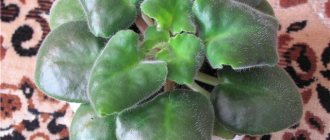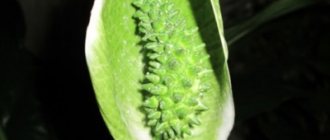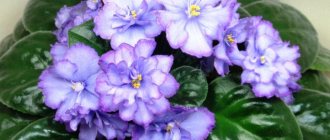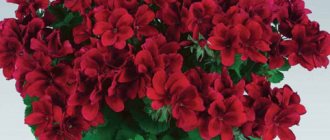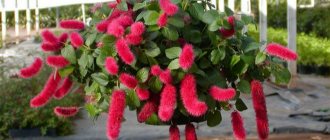- January 9, 2019
- Flowers
- Efimova Anastasia
The anthurium plant is considered one of the most unusual and exotic to keep at home. This representative of the plant world came to us from the tropical zone of South America, which means that creating a suitable microclimate for it in an apartment is not so easy.
But flower growers are not afraid of difficulties, because this plant literally attracts the eye with its bright shiny foliage and extraordinary “waxy” flowers. It is for the shape of the bud that the anthurium got its name - from Greek it is translated as “flower-tail”. The inflorescence looks like a spadix, around which a bright cloak of red, white, green or deep burgundy is spread.
Anthurium picks up color well even at home: in cold periods there can be 3-4 flowers on a bush, in warm periods - up to 8-12. The fruits are juicy, fleshy berries. All parts of the plant are poisonous.
Novice gardeners often ask why anthurium blooms with small flowers. As a rule, this phenomenon is observed several years after purchase, and every year smaller and smaller inflorescences appear on the plant. So why do anthurium have small flowers? In order to answer this question, you must first find out how to properly care for the plant and in what conditions to keep it.
Popular types
There are several types of anthurium that are especially popular among home plant lovers, namely:
- Andre is an epiphytic (naturally grows on the bark of trees) plant with a short stem, bright heart-shaped foliage (white, all shades of green, burgundy or speckled). The most popular species for home breeding.
- Anthurium Scherzer. An epiphytic plant with dense green leaves up to 20 cm long of different shapes (depending on the specific variety). The peduncle grows from 15 cm to half a meter, the ear is spiral. The berries are orange-red.
- Baker's Anthurium. A low epiphyte with a short stem and belt-shaped narrow leaves up to half a meter long. The leaves are green on the front side, covered with reddish specks on the back. The inflorescence cover is leathery, light green, and small in size. Cob – up to 10 cm long. The berries are small, scarlet in color.
- Anthurium Hooker. An epiphytic plant with large green leaves with black speckles, growing in a rosette. The bedspread is narrow and green. Peduncle – 45-90 cm.
- Climbing. Epiphyte up to 90 cm tall with bright leathery oval leaves. There are black spots on the inside of the leaf. The peduncle is small, up to 6 cm, green or red. The blanket is green, up to 15 cm long. The color of the fruit depends on the variety.
- Multi-dissected. This is a vine with palmately dissected leaves with wavy edges. The peduncle often reaches 25 cm in length. The berries are red.
- Crystal. A plant with large, broad, heart-shaped leaves, velvety and with a white vein on the front side. The peduncle is up to half a meter, the cob is usually half that size.
Now, to answer the question why anthurium has small flowers, you need to find out how to properly maintain it.
Watering
Watering needs to be balanced, without waterlogging or drying out the soil. The first is much more dangerous, since the roots will rot. Therefore, it is important to always drain the water remaining in the pan.
In summer you need to water the flower every three days; in winter it is recommended to moisten the soil once a week. But this may not be enough, since in winter apartments are often hot and dry, and the soil dries out quickly.
Optimal air humidity is 70%. Therefore, you need to spray the flower regularly, and also wipe the leaves with a damp cloth.
Anthurium does not like lime water - it can react to it by yellowing the leaves. Therefore, for irrigation it is necessary to use clean melted or filtered lukewarm water.
Anthurium - why small flowers. It looks like an adult flower, I’ve had it for 2 years, and the cieta on it are getting smaller
The main thing is that your anthurium is alive! Plants do not grow or do not bloom or bloom poorly or do not bear fruit only because the conditions of their maintenance do not correspond to those necessary for their development... Usually this is one or more of the following indicators: Illumination (low - too high), illumination time (light too long or short day), insufficient or excessive watering, too large a pot (the plant grows bark mass, not greenery) or not enough soil (the plant has outgrown the pot - only roots), not enough organic, mineral substances in the soil. Some plants do not like drafts, and some cannot tolerate the presence of, for example, gas combustion products in the atmosphere (i.e. they cannot be placed in the kitchen with a gas stove...).
So, after all, it’s not a matter of hormones, especially since your anthurium is already 2 years old. It just definitely lacks 1) light (flowers usually shrink when there is insufficient lighting) and 2) since the plant is a potted plant, it is imperative to give the plant, especially a flowering one, fertilizer 2 times a month in the summer and 1 time a month in the winter!
If you bought Dutch, then this is natural and applies not only to anthurium. Grown on hormones
Flowers can become smaller for the following reasons: - lack of light - lack of nitrogen fertilizer - small pot ANTHURIUM NEEDS A LOT OF LIGHT (daylight hours are at least 10 hours)
indoor-plants-tips.ru
Soils and fertilizers
Why do anthurium have small flowers? Care plays an important role, and here the correct choice of substrate for planting and regular feeding should not be underestimated. The soil for the plant must be loose and with good drainage. Soil mixtures intended for orchids are well suited for anthurium. You can also use soil made from deciduous soil, peat and sand with pieces of pine bark.
Fertilizing is applied only during periods of intensive growth, that is, in winter and summer. Frequency – once every two weeks. You can use both mineral complexes (in the form of solutions) and organic fertilizers, such as chicken manure.
Plant care
The air around the plant should be well humidified. It needs to be sprayed a lot and often, and sometimes the foliage needs to be wiped with a damp cloth. To strengthen and develop the growth of adventitious roots, you need to cover the stems with moss. If you comply with all the requirements, the anthurium will bloom magnificently all summer.
In spring and summer, the flower grows, it needs to be fed, fed every 15 days, alternating organic and mineral fertilizers. The flower is replanted annually in the spring (if the base of the flower is more than 25 cm wide, replant it once every six months).
There are many reasons why flowers can become pale and small. This can be either a consequence of improper care or one of the signs of illness. Before taking active action, you need to find out the cause, and then effectively eliminate it.
Transfer
Inexperienced flower growers can come up with their own answer to the question of why anthurium has small flowers. Some of them think that this is due to incorrect or untimely transplantation. In fact, this is rarely true. Due to mistakes during replanting, the plant may turn yellow, fail to gain color, and even die. Whereas anthurium often has small leaves and flowers for other reasons.
The plant still needs to be replanted: after purchase - after 10 days, young specimens - annually, mature plants - once every three years.
Reproduction
The easiest way to propagate anthurium is by apical cuttings - they are rooted in damp sand and covered with film to create a greenhouse effect. Such plants need to be ventilated daily.
It is more difficult to propagate a flower by dividing a bush, as the roots can easily be damaged. However, this is many times easier than trying to grow anthurium from seeds.
To do this, cross-pollination is carried out during the flowering period, and the resulting fruit, after ripening, is removed with tweezers. Then it ripens for another 6-8 months, after which the seeds can be sown in loose soil and wait for sprouts.
So why do anthurium have small flowers? There are actually not many reasons, so you can find the source of the problem quite quickly.
Landing rules
- To grow anthuriums, special soil mixtures for epiphytes are used. If necessary, you can make the mixture yourself. Advice. To make a high-quality soil mixture, you need to thoroughly mix one liter jar of leaf, coniferous soil and peat, adding a half-liter jar of sand, and a handful of crushed charcoal.
- When planting, you should carefully inspect the roots, remove rotten areas and clean up to healthy tissue. The sections are sprinkled with crushed charcoal, and in case of rot - with fungicides. Important! Before planting in the ground, the roots need to be wrapped in damp moss so that they do not dry out.
- For planting, choose shallow, wide flowerpots and make drainage from expanded clay that absorbs excess water.
- For regular replanting, you need a pot 2-3 cm larger in diameter than the previous one to give the roots enough space to develop.
- After planting, the plant is watered abundantly and shaded from light for 1–2 days.
Malnutrition
There is another reason why anthurium has small flowers and leaves. The plant may gradually weaken due to a simple lack of nutrients. This happens due to a lack of fertilizing or due to soil depletion. What to do in such a situation?
The solution is obvious: you need to transplant the flower into a pot with fresh substrate. If this happens during the flowering period, or it is not yet time for the plant to move to a new apartment (according to the time intervals indicated above), then the anthurium must be replanted using the transshipment method. That is, choose a slightly larger container and move the plant into it without shaking the earthen ball. And pour fresh substrate on the sides and top. After a couple of weeks, the plant can be fertilized with mineral or organic fertilizers.
Natural aging
There is another option why anthurium has small flowers. The reason is the natural aging and gradual degeneration of an adult plant. Interestingly, mature specimens look different from different gardeners. For some it will be a lush and green bush with crushed inflorescences, for others the number of flowers will be reduced to 1-2.
But overall the picture will not be very happy. Anthurium will lose its exotic appearance, turn pale, and its stem will become bare. In the future it will simply stop blooming.
In this case, the plant needs to be healed and rejuvenated. The operation consists of removing the ground part so that a pair of aerial roots remain on the cutting. At the same time, the plant is replanted and a little growth stimulator is added for good rooting.
The young shoot must be kept at a temperature of +20-22⁰ and regularly sprayed with warm water.
How to propagate anthurium correctly
The main methods of propagation are dividing the bush, cuttings and separating shoots. Let's consider each of them in order.
Dividing the bush
When replanting, you need to choose the moment when the bush has grown so much that it becomes possible to divide it.
Then, carefully, using your hands or a sharp knife, separate part of the rhizome, sprinkle the sections with crushed coal, and the resulting young plant is planted separately.
For some time you need to place it in a home greenhouse or wrap it with damp sphagnum moss.
Cuttings using apical cuttings
A more effective method that allows you to get several copies at once, almost painlessly for the mother bush.
They act this way:
- Separate the leaf with a piece of stem so that there is a bud on the cutting.
- The cut is dried in air, it can be treated with a root formation stimulator, for example, heteroauxin;
- Dip the cutting into clean, soft water or moist, light soil.
- Place the planted cuttings in a home greenhouse or cover them with glass jars for 2–3 weeks until roots appear.
- Rooted cuttings are planted in small flowerpots.
Separation of shoots
Lateral shoots appear regularly in an adult plant, provided proper care and sufficient moisture are provided.
To propagate anthurium in this way, you need:
- At the time of transplantation, carefully separate the roots of the shoot from a lump of earth with a small section of the rhizome of the mother plant, and treat the sections with crushed coal.
- Inspect the roots of the offspring, remove damaged or weak ones.
- If the shoot has more than three leaves, leave the three best ones and remove the rest without damaging the growth buds.
- Plant the plant in a light substrate and place it in conditions of high humidity.
Important! It is necessary to regularly wash and disinfect flowerpots and trays. For disinfection purposes, a strong solution of potassium permanganate is quite suitable.
